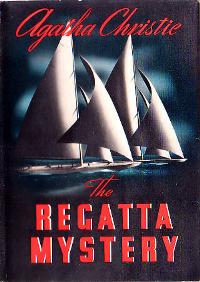The Regatta Mystery

Dust-jacket illustration of the first US edition
|
|
| Author | Agatha Christie |
|---|---|
| Country | United States |
| Language | English |
| Genre | Crime novel |
| Publisher | Dodd, Mead and Company |
|
Publication date
|
1939 |
| Media type | Print (hardback & paperback) |
| Pages | 229 pp (first edition, hardback) |
| Preceded by | And Then There Were None |
| Followed by | Sad Cypress |
The Regatta Mystery and Other Stories is a short story collection written by Agatha Christie and first published in the US by Dodd, Mead and Company in 1939. The first edition retailed at $2.00.
The stories feature, with one exception (In a Glass Darkly), Hercule Poirot, Miss Marple or Parker Pyne, Christie's famed detectives. The collection was not published in the UK and was the first time a Christie book was published in the US without a comparable publication in the UK; however all of the stories in the collection were published in later UK collections (see UK book appearances of stories below).
The Regatta Mystery (the title story) has Mr Parker Pyne catch a diamond thief during regatta festivities at Dartmouth harbour.
The Mystery of the Bagdad Chest concerns how a dead body found its way into the titular chest in the midst of a dance party. Arthur Hastings chronicles Hercule Poirot's unravelling of the mystery.
How Does Your Garden Grow? is a line from the nursery rhyme "Mary, Mary, Quite Contrary", which Poirot is reminded of when visiting a country house with a beautifully maintained garden whose mistress has just died – after writing a cryptic letter requesting his help.
The Problem at Pollensa Bay concerns a mother's dislike for her son's fiancee. The problem is solved (non-violently) by fellow vacationer Parker Pyne.
In Yellow Iris, Poirot follows an anonymous phone call to a restaurant table laden with the favourite flower of a woman who died mysteriously four years before. This story was expanded and made into the full-length mystery Sparkling Cyanide, featuring Colonel Race instead of Poirot.
...
Wikipedia
